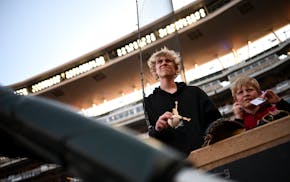Sometimes known as the "rabbits" of northern Minnesota, snowshoe hares have been changing from brown to their white winter coats. By now they are nearly white, except for the black tips of their ears. They will remain this way until April.
The unusually large feet, covered with long, dense fur, enable the hare to travel on or near the top of deep snow, much like humans on snowshoes. Many times I have taken students on hikes at Wolf Ridge Environmental Learning Center, located near Finland, Minn., or the North Shore of Lake Superior to study the hares. It can be tough to detect these "ghosts" against a backdrop of snow, but we usually see at least one.
Snowshoe hares prefer dense cover during the day but venture into open areas for feeding at night. Their food consists mainly of green vegetation during summer months. They eat twigs, buds and the bark of shrubs and small trees during the winter.
Female hares begin breeding when they are about a year old, and they have two to three litters of four to six young annually. Foxes, wolves, owls and the Canada lynx take advantage of this fruitfulness. All rely on the nonhibernating hares as a reliable source of winter food. The 2-ounce babies, called "leverets," are born fully furred and with their eyes open, and are able to walk by the time their fur has dried.
It is well-known that populations of snowshoe hares fluctuate wildly. In a period of 10 years it may increase from a singe hare to several hundred in a square mile. Then, within a few months, it may decrease again due to disease, overcrowding, dwindling feed supplies, predation or other factors.

Live: Twins vs. White Sox. Follow the action on Gameview
![Glen and Becky Taylor during game 1 on Saturday, April 20, 2024, at Target Center in Minneapolis, Minn. ] CARLOS GONZALEZ • carlos.gonzalez@startri](https://arc.stimg.co/startribunemedia/X74AVHP3ZBD4TPPPDJTNX5LN6M.jpg?h=91&w=145&fit=crop&bg=999&crop=faces)
Gameview: Wolves vs. Suns in Game 2. Up-to-the-second updates here.
Paris main airport unveils new baggage handling system ahead of the 2024 Olympics

